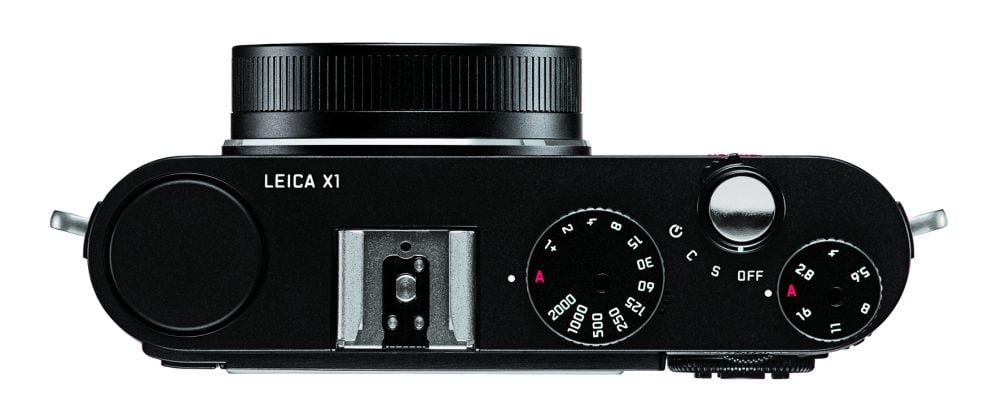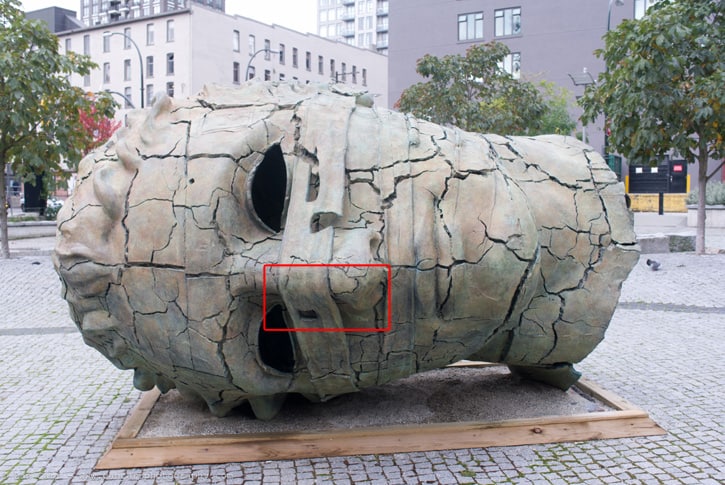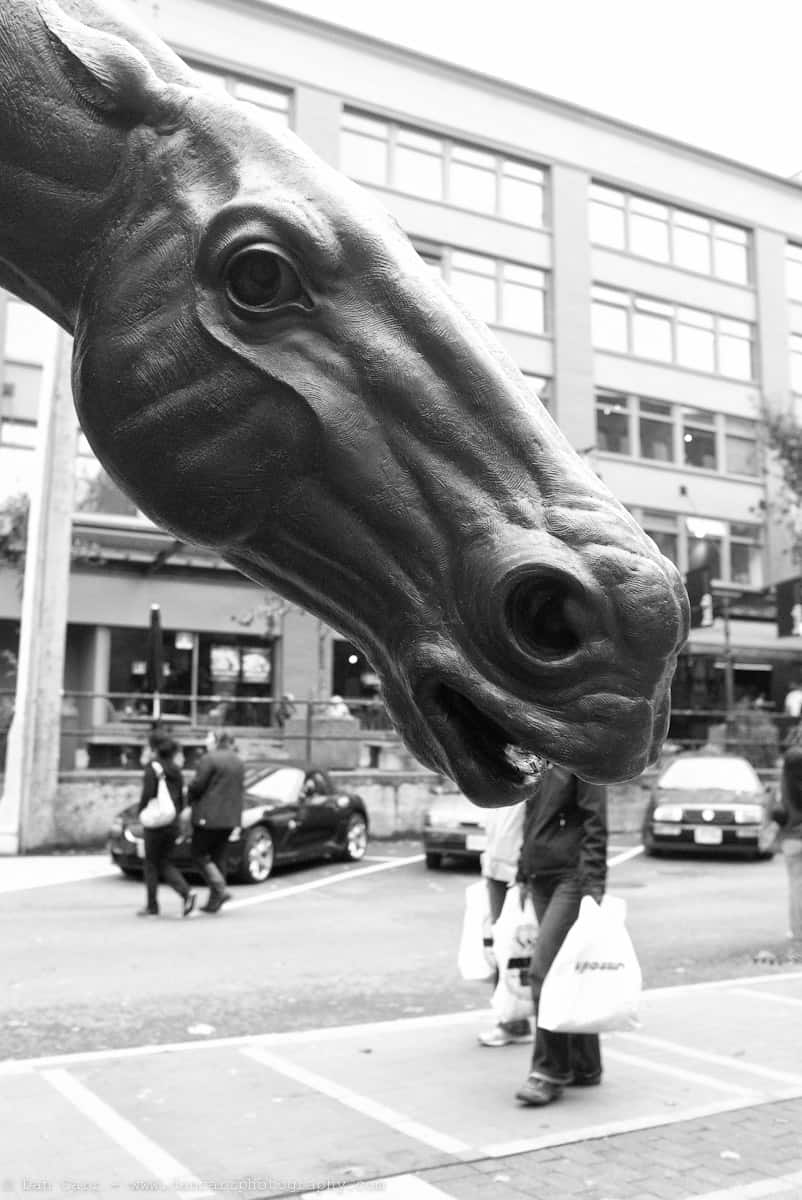The X1 was launched by Leica alongside the M9 back in September 2009 and a new all black version was displayed at Photokina this year, set to ship within the next month. For those unfamiliar with this camera there are a few stand out features that immediately set this camera apart from other compacts. Firstly Leica have managed to squeeze a 12MP APS-C sized sensor into the diminutive X1 body which is an impressive achievement and immediately gives it an advantage over most other compact cameras. Secondly the X1 features a fixed 24mm Leica Elmarit lens. Elmarit in Leica land means that it has a maximum aperture of f2.8 and the 24mm on the APS-C sensor gives it an equivalent focal length of about 35mm.
A week ago I met with Leica representatives in Vancouver to try out both the M9 and also the X1. I thought I would start things off with the X1 though as the M9 was in my hands for a lot longer and so the resulting article is taking me a little longer to tackle. I was able to spend an afternoon handling the X1 though and taking some sample shots on a walk in the city. Read on to find out my thoughts on this unique little camera.
The first thing that surprised me was just how light the camera is. It’s not a big camera at all, but being bigger than my current pocket sized solution, the Canon S90, I was expecting it to weigh a lot more than it did. In fact the X1 weighs in at 286g which is still easily within the realms of pocket-able mass, albeit pushing the limits of easily pocket-able bulk. It’s no shirt pocket camera but you could put this in a jacket pocket and easily forget it was there all day. The design of the fixed Elmarit lens is such that it retreats into the camera when you power it down, considerably decreasing the size .
The styling of this camera really is everything you have come to expect from Leica, and in many ways looks mike a mini M camera without the rangefinder. The body is constructed from aluminum top plates and magnesium shell that helps to keep the weight down and the durability up. My only complaint about the build quality was a slightly wonky mode selection dial but it was a minor grievance and given that I was using a camera that had been tested by many many people prior to me, it could be that it has been through the wars somewhat. The aluminum dials on the top of the camera make a satisfying click as they turn and although not quite as nice as the m9 (which is 4 times the price) it still exudes a level of craftsmanship that is very pleasing to handle. Despite a lack of any specific shaped grip, the rounded edges to the design sit in your hand comfortably and whilst there is an accessory grip available, to me it is not nearly as beautifully designed as the camera to which it would be attached. I did not feel the need for any further grip.
As with the M9, the menu system is very intuitive and simple and most of the controls are done with a 4-way thumb pad which has a rotating wheel around the outside. There is a further horizontally moving thumb wheel above the thumb pad which is used to browse photos during playback, and to focus when in manual focus mode. Where the main rotating dial has some detents around its circumference to give the feel of different positions, the top thumb wheel does not, which I found to feel quite strange. On the left of the 2.7″ screen there is a dedicated ISO and white balance buttons which I love to see as well as the usual playback and information buttons that are commonplace on most cameras. The general button layout is well thought out and much more user friendly that my little Canon S90 though image playback on the screen is very very slow. In general whilst the menu operations and button layout is spot on in my opinion, it is really hampered by the speed at which things are handled and it just doesn’t hold up to the lofty goals achieved by the physical design of the camera.
Shutter speed and aperture are controlled by the dials on the top of the camera. Switching both dials to “A” gives you automatic program mode. Leaving shutter on “A” and selecting an aperture manually gives you aperture priority mode and vice versa. Nice and simple but giving you as much or as little control as you want. The screen itself was a little disappointing and at only 230,000 pixels resolution, is considerably outclassed by most other cameras. In fact it has a full half as many pixels as my Canon point and shoot and by today’s standards it just did not quite cut it compared with the design of the rest of the camera. Definitely my biggest gripe in terms of the features and design. Whilst they did not manage to fit an optical viewfinder into the camera, they did squeeze in a pop-up flash which is neatly exposed by a gentle push on the flash itself….. popping it up!
I guess I should stop and take a second here to explain what interested me about this camera and why I wanted to give it a try. I keep mentioning the S90 because that is a camera that I carry with my every day. As a photographer, I never like to be without a camera of some sort, but sometimes it’s just not practical to carry my SLR with me. The image quality of most point and shoot cameras makes me want to cry, and not in a good way. When you shoot every day with full frame Canon cameras, you end up demanding a lot from you every day pocket camera too. The little Canon S90 (recently superseded by the S95) takes the sensor from a Canon G11 and crams it into a smaller body with RAW image capture and manual controls. It’s the first point and shoot that I have owned that I have used to capture images that I am actually proud of and it has been well received by many professional photographers. As I carried the S90 all over the world last year on assignment for my clients, I found myself capturing more and more great images with the S90 because it was always there with me, and often went unnoticed by my subjects. I have even had a couple of shots published in national magazines that were taken with that camera. The one area where I wish it was better was high ISO though. The S90 has a tiny sensor and it does a commendable job for something of its size, but it would never be able to compete with a camera that had a DSLR sized sensor. And that is where the X1 comes in. Not much bigger than the S90, but packing a sensor 10 times the size. I was interested to see if the extra cost of the X1 was reflected in the better quality of the images it produced because I am a firm believer in having a camera of some sort, with you at all times.
Anyway…onwards with the X1. The X1 has been widely criticized for having slower than average auto focus. I think part of the problem here is that it occupies a very narrow niche in the market right now. It is neither a point a shoot camera nor an SLR. It’s also not a Micro Four Thirds camera, of which there are now a great many. Because of it’s larger SLR sized sensor, it has probably been compared to the AF speed of larger cameras. There’s no denying that it’s not a speedy camera when it comes to AF, but because it is not an SLR it has no optical prism or shutter mechanism like an SLR. It is therefore limited to using the much slower method of contrast detect auto focus. Yes it is slower than an SLR, and M4/3 cameras but I did not find it noticeably slower than a point and shoot camera so it really depends which way you choose to do your comparison. You aren’t going to try and shoot sports with a fixed 24mm lens anyway and from my short walk around the city with it I was not troubled by it. I like the ability to select just a central AF point and then use the focus/re-compose method for shooting. This is how I shoot most of the time with my SLR so it was second nature. There is a manual focus mode too which brings up an enlarged box on the screen which is zoomed in to help with critical focus. Focus is adjusted using the thumb wheel but in practice I could not find a use for this. Moving from one end of the focus scale to the other end with the thumb wheel was slow and did not leave much room for accuracy as only a couple of points were marked onto the scale. The lens also stops down it’s aperture in this mode, so you loose the ability to really preview any sort of selective focus you might be trying to achieve with a wide open f2.8 aperture. It was suggested to me by one of the Leica representatives that manually selecting a focus of 6ft and having the camera at about f8 is a good solution for general street shooting where speed can be necessary to capture the elusive “decisive moment”. I gave it a try but it is a limiting method because if you want to suddenly shoot something far away then you are at the mercy of the speed of manual focus wheel or you have to exit manual mode and return to AF before taking the shot. Personally I would not try to re-create the M9 experience though, the X1 is a different camera and I was quite happy to shoot in single point AF mode, which even has a handy Spot AF mode for even greater focus accuracy. Also worth a quick mention here is battery life. I’m used to shooting for days at a time on the batteries in my SLRs and whilst I know this is no SLR I would have expected it to last at least as long as a point and shoot camera. Unfortunately my battery ran out before the end of my short walk, and that was the same story with several other X1 equipped people with me. Definitely needs improvement…..
First and foremost though this camera is all about creating images. It forgoes a lot of the fuss of other cameras to deliver a simplified shooting experience with a sensor that, given it’s size, has the potential to take some great photos. So how did it do in this regard ? In a word, awesome. I wish I had a little more time with the camera but I was able to take a range of images and test a range of ISO and apertures. I shot the whole time in DNG + JPEG Fine mode. Normally I shoot only in raw, but for some reason there is no DNG only mode with this camera. One advantage to this mode though is that selecting one of the color options from the menu will apply that option to the JPEG and leave the DNG file untouched. If you want to shoot in black and white, this gives you a nice little way to get a nice looking black and white image straight out of the camera but at the same time have the full color version for you to manually adjust to your liking when you have the time. This I really liked and I shot a lot of the time in high contrast black and white mode.
Straight from camera JPEG shot in “High Contrast” black and white mode. Wide open at f2.8, iso 400 (click for larger)
ISO Testing
A sensor 10x larger than a point and shoot camera has 2 main benefits, greatly improved high ISO performance and a much shallower depth of field. Whilst the shallow DOF is nice, it was the high ISO shots that I really wanted to see so I took one of the statues from the street nearby and shot the full range of of ISO options. Sticking with this same statue I did a quick hand held ISO test and I have posted 100% crops from an area of the image to give you an idea. These shots are from the DNG files and no noise reduction has been applied during processing in Lightroom 3.0. As you can see, pretty impressive results. A tiny bit of reduction would clean up iso 1600 without problem and even iso 3200 would produce some great images. Iso 100 -400 is essentially totally noise free.

Detail testing
This shot was taken with the lens wide open at f2.8. The quality of the Leica Elmarit lens really shines at low apertures compared with competitors and it even improves further when stopped down. Quite remarkable for a collapsing lens design that is so small.
iso 800 , f2.8, 1/1000
This shows a 100% crop of the horse’s eye. Taken from the DNG with only minimal default sharpening.
Close focus
Where I did run into issues though was the close focusing distance of the Elmarit lens. In regular AF mode it is limited to 60cm and in manual or macro AF mode it goes down to 30cm. My S90 will focus all the way down to 5cm !! I continually found myself having to back away from things I wanted to shoot, in order to get the requisite 30cm distance and I found for the type of shooting I do, this was far more frustrating than a slightly lethargic AF system. I would really like to see this improved upon in the next iteration of this camera. Even when I travel with my 5dMKII in hand I tend to throw on the 24mm f1.4 II lens while I’m walking around and even that focuses closer than the X1.
Close focusing limit at 30cm. f2.8, flash ON, iso400 1/30 second
f3.2, iso400, 1/100 Great rendition of colors.
f8, iso800, 1/160th
iso400, f7.1, 1/200 – Vivid JPEG mode
Conclusion
My time with the X1 was short but sweet so I will keep my conclusion that way too. This is a camera designed for photographers and even if you have never used it before you will be shooting away happily in 30 seconds. You will be even happier when you get a look at the images it is producing. For something so small, it packs a power to weight ratio that is better than anything I have ever seen. I don’t have any first hand experience with the Sigma DP2, the X1’s main rival, and the Fujifilm X100 is yet to be released so an unknown quantity but I would bet an awful lot that in terms of pure image quality neither of them come close. The Elmarit lens displays the quality you would expect from Leica glass and the Kodak CMOS sensor does a great job at delivering images at high ISO. Even at 3200 its possible to produce an image that needs only very minimal noise reduction in order to make a beautiful print. The fact that the X1 includes a free copy of Lightroom 3.0 means you have access instantly to Adobe’s fantastic new noise reduction algorithm to do just that.
Yes it kind of looks like a miniature M9, no it is nothing like shooting with an M9. It’s not the fastest camera out there but I never felt like it was holding me back from taking pictures. The experience could be further improved with faster internal software and a much better screen is needed but overall I was mightily impressed by what the camera was able to produce. Whether this fits into your budget is something only you can answer. It’s by no means a cheap camera, but for those that say ” you could buy an slr and 2 lenses for that price” well…….. you’ve kind of missed the point. For me this is all about pocket power, about having the camera there when you need it and having a tool that can produce a stunning print worthy image in a huge range of conditions. Oh and make sure you buy a couple of extra batteries!
If you enjoyed reading this article please consider buying the camera using one of the links below. It helps me to add to the site!


















